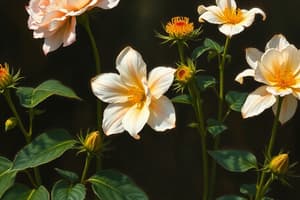Podcast
Questions and Answers
What is the term for the seed-bearing plants of today?
What is the term for the seed-bearing plants of today?
- Gymnosperms
- Angiosperms (correct)
- Lycopods
- Bryophytes
When did evidence of the emergence of embryophyte land plants first occur?
When did evidence of the emergence of embryophyte land plants first occur?
- 470 million years ago (correct)
- 1 billion years ago
- 850 million years ago
- 390 million years ago
What type of tissue did some free-sporing plants like Archaeopteris have by the late Devonian?
What type of tissue did some free-sporing plants like Archaeopteris have by the late Devonian?
- Meristematic tissue
- Ground tissue
- Epidermal tissue
- Secondary vascular tissue (correct)
Which group of plants exemplifies the earliest groups thriving in marine environments?
Which group of plants exemplifies the earliest groups thriving in marine environments?
At what time did communities of complex, multicellular photosynthesizing organisms exist on land?
At what time did communities of complex, multicellular photosynthesizing organisms exist on land?
By the late Devonian, some free-sporing plants such as Archaeopteris had ______ tissue that produced wood
By the late Devonian, some free-sporing plants such as Archaeopteris had ______ tissue that produced wood
The evolution of plants has resulted in a wide range of complexity, from the earliest algal mats of unicellular archaeplastids evolved through ______, through multicellular marine and freshwater green algae
The evolution of plants has resulted in a wide range of complexity, from the earliest algal mats of unicellular archaeplastids evolved through ______, through multicellular marine and freshwater green algae
Many of the features recognised in land plants today were present, including roots and ______, by the middle of the Devonian
Many of the features recognised in land plants today were present, including roots and ______, by the middle of the Devonian
There is evidence that cyanobacteria and multicellular photosynthetic eukaryotes lived in freshwater communities on land as early as 1 billion years ago, and that communities of complex, multicellular photosynthesizing organisms existed on land in the late ______
There is evidence that cyanobacteria and multicellular photosynthetic eukaryotes lived in freshwater communities on land as early as 1 billion years ago, and that communities of complex, multicellular photosynthesizing organisms existed on land in the late ______
Evidence of the emergence of embryophyte land plants first occurs in the mid-Ordovician, around ______ years ago
Evidence of the emergence of embryophyte land plants first occurs in the mid-Ordovician, around ______ years ago
Evolution of plants has resulted in a wide range of complexity, from the earliest algal mats of unicellular archaeplastids evolved through ______
Evolution of plants has resulted in a wide range of complexity, from the earliest algal mats of unicellular archaeplastids evolved through ______
By the late Devonian, some free-sporing plants such as Archaeopteris had ______ tissue that produced wood
By the late Devonian, some free-sporing plants such as Archaeopteris had ______ tissue that produced wood
Evidence of the emergence of embryophyte land plants first occurs in the mid-Ordovician, around ______ years ago
Evidence of the emergence of embryophyte land plants first occurs in the mid-Ordovician, around ______ years ago
There is evidence that cyanobacteria and multicellular photosynthetic eukaryotes lived in freshwater communities on land as early as 1 billion years ago, and that communities of complex, multicellular photosynthesizing organisms existed on land in the late ______
There is evidence that cyanobacteria and multicellular photosynthetic eukaryotes lived in freshwater communities on land as early as 1 billion years ago, and that communities of complex, multicellular photosynthesizing organisms existed on land in the late ______
What is the term for the seed-bearing plants of today?
What is the term for the seed-bearing plants of today?
What is the term used for the earliest algal mats of unicellular archaeplastids evolved through endosymbiosis?
What is the term used for the earliest algal mats of unicellular archaeplastids evolved through endosymbiosis?
During which time period did evidence of the emergence of embryophyte land plants first occur?
During which time period did evidence of the emergence of embryophyte land plants first occur?
What specific tissue did some free-sporing plants like Archaeopteris have by the late Devonian?
What specific tissue did some free-sporing plants like Archaeopteris have by the late Devonian?
What term is used for the seed-bearing plants of today?
What term is used for the seed-bearing plants of today?
During which time period did communities of complex, multicellular photosynthesizing organisms exist on land?
During which time period did communities of complex, multicellular photosynthesizing organisms exist on land?
Flashcards are hidden until you start studying
Study Notes
Key Terms and Concepts
- Seed-bearing plants of today are referred to as angiosperms and gymnosperms.
- The earliest algal mats evolved through endosymbiosis, giving rise to multicellular forms.
Emergence of Plants
- Evidence of the emergence of embryophyte land plants is first found in the mid-Ordovician, approximately 470 million years ago.
- Cyanobacteria and multicellular photosynthetic eukaryotes were present in freshwater communities on land as early as 1 billion years ago.
Plant Evolution Timeline
- Late Devonian marks the existence of complex, multicellular photosynthesizing organisms on land.
- By the late Devonian, free-sporing plants like Archaeopteris possessed vascular tissue that allowed wood production.
Structural Features
- By the middle of the Devonian, land plants exhibited key features such as roots and stems.
Plant Diversity
- The evolution of plants has led to significant complexity from simple unicellular archaeplastids to diverse forms including multicellular marine and freshwater green algae.
Studying That Suits You
Use AI to generate personalized quizzes and flashcards to suit your learning preferences.




